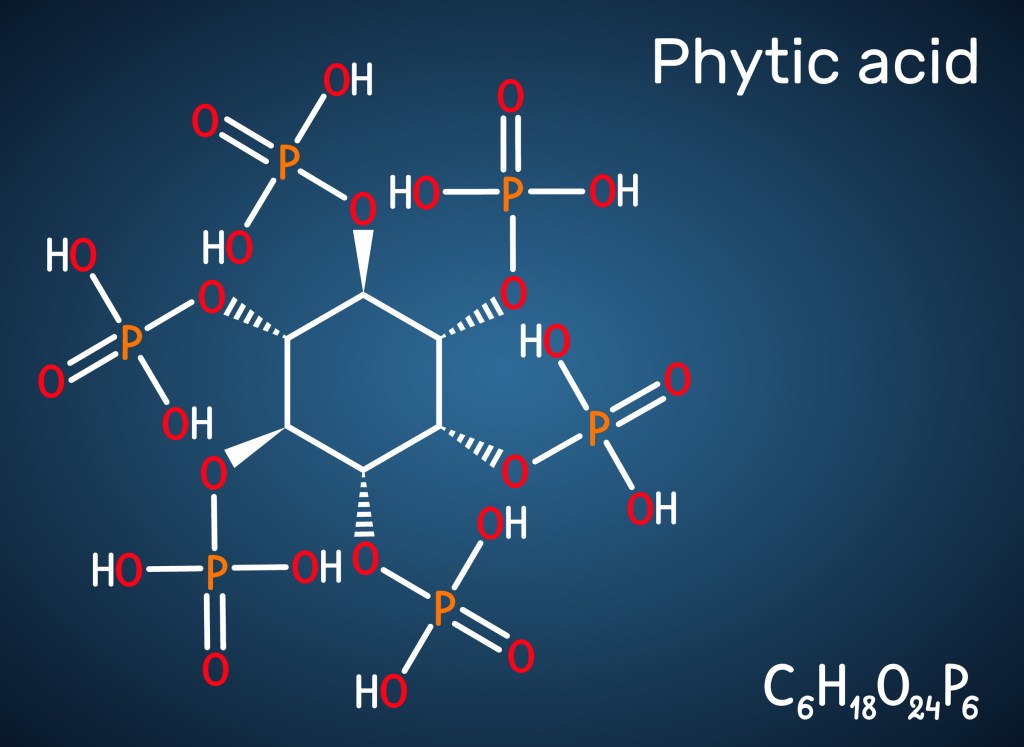At a glance
Phytic acid in nuts such as almonds, walnuts, and Brazil nuts may reduce the risk of certain cancers, enhance bone health, and improve blood sugar control. However, excessive intake can cause digestive issues, impair nutrient absorption, and contribute to mineral deficiencies.
Phytic acid, also known as inositol hexakisphosphate, is a naturally occurring chemical found in nuts, seeds, and whole-grain cereals. While phytic acid offers various health benefits, it can also lead to reduced absorption of important minerals.
Let’s take a detailed look at phytic acid, its role in health and mineral absorption, and what you can do to get the maximum nutritional benefit from eating nuts.
What is phytic acid?
Phytic acid, or phytate, is found in most edible seeds, such as nuts, whole grains, and legumes. Its primary roles are to protect the seed from damage and store large amounts of phosphorus for later use.
Once the seed germinates, phytic acid releases phosphorus, which acts as a natural fertilizer, helping the seed to grow into a young plant.
It’s not uncommon to find phytic acid added to commercial food products. It’s a potent antioxidant and preservative that extends the shelf life of foods.
Watch the video below to learn more about phytic acid in nuts.
Phytic acid side effects
Dietary phytates can cause digestive issues and impair the intestinal absorption of nutrients, reducing the mineral bioavailability of foods and leading to potential abdominal discomfort.
Phytic acid can inhibit the activity of digestive enzymes, resulting in sluggish digestion, bloating, and discomfort. Whether phytic acid causes symptoms depends on your digestive health, enzyme levels, and overall diet, which explains why some people react to phytate-rich foods and others don’t.
Additionally, due to its chemical structure, phytic acid is considered an antinutrient. It binds easily to certain minerals and can prevent their absorption in the body, and regularly consuming phytates may result in mineral deficiencies.
Here are four mineral deficiencies linked to phytic acid intake.
1. Iron deficiency
Phytic acid can inhibit iron absorption, particularly nonheme iron from plant sources. This may increase the risk of low iron levels, especially in individuals following vegetarian or vegan diets.
Heme iron, found in animal protein, is less affected by phytic acid. As a result, those who avoid animal foods may be more susceptible to iron deficiency.
Iron deficiency can cause anemia, lack of energy, heart palpitations, and low exercise tolerance.
2. Zinc deficiency
Too much phytic acid can lower your body’s ability to absorb zinc, potentially increasing the risk of zinc deficiency.
Zinc affects immune function, skin health, and cellular repair, and signs of low zinc status may include delayed wound healing, dermal issues, and increased sensitivity to cold.
3. Calcium deficiency
Eating calcium-rich foods in combination with foods high in phytic acid can lead to significantly reduced absorption of calcium.
Calcium deficiency increases your risk of osteoporosis, poor dental health, muscle cramps, and insomnia.
4. Copper deficiency
Phytic acid may also impact copper absorption. Copper supports energy metabolism, iron transport, and blood sugar regulation.
Insufficient copper levels may contribute to symptoms such as low energy, muscle weakness, insulin resistance, and anemia.
If you suspect a nutrient deficiency or are thinking about dietary changes to support a health condition, consult a healthcare provider to assess any potential mineral imbalances and help you create an appropriate approach based on your individual needs.

Phytic acid benefits
Despite being classified as an anti-nutrient, phytic acid has positive health effects and can safely be a part of a balanced diet. The same chemical structure responsible for blocking nutrient absorption also has potent antioxidant properties.
Here are five health benefits of phytic acid.
1. May reduce the risk of colon cancer
Research published in Nutrients found that dietary phytate, especially when combined with butyrate–a beneficial compound produced by gut microbes–can disrupt cancer cell growth and promote cellular health in the lining of the colon.1
While the mechanisms are still being studied, the results suggest that phytate-rich foods may help maintain healthy colon cell function and protect against abnormal cell changes.
2. Improved blood sugar control
Phytic acid is believed to support pancreatic function and balanced insulin production, lowering the risk of insulin resistance and type 2 diabetes.
3. Reduced mineral overload
Because of its affinity to bind with minerals, phytic acid can support healthy nutrient levels by binding to excessive amounts of minerals in the body.
Some people are prone to accumulating excessive levels of iron and zinc, which is associated with an increased risk of DNA damage and chronic disease. Phytates are believed to help minimize the risk of excessive iron levels and protect the body from the harmful effects of mineral overload.
Phytic acid may also help prevent calcium crystallization, which can lower the risk of kidney stones.
4. Supports digestive health
Beneficial bacteria, such as lactic acid bacteria, in your gut produce microbial phytase, an enzyme that breaks down phytic acid. The more phytate-rich foods you eat, the more microbial phytase your microbiome will produce.
According to research published in Trends in Food Science & Technology, microbial phytases may enhance nutritional bioavailability and support gut microbial balance, highlighting their potential role in digestive health.2
5. Supports bone health
Phytate’s ability to bind to calcium can benefit bone health. It reduces the risk of osteoporosis by preventing the breakdown of calcified minerals in your bones.

High phytic acid nuts
Nuts have a considerably higher phytic acid content than other plant foods, and some nuts contain more phytic acid than others.
The nuts with the highest amount of phytic acid are:
- Almonds – 9.4 percent phytic acid
- Walnuts – 6.7 percent phytic acid
- Brazil nuts – 6.3 percent phytic acid
How to reduce phytic acid in nuts
If you experience bloating or discomfort after eating nuts, phytic acid could be the reason. Fortunately, there are ways to help reduce phytic acid levels in nuts and, as a result, lower the risk of phytate-related mineral deficiencies and gastrointestinal symptoms.
According to a study published in the Journal of Food Composition and Analysis, “soaking is an effective process for removing antinutritional factors.” The authors reported that after 10.6 hours of soaking pine nuts at 135°F (57°C), phytate content decreased by 61 percent.3
“Soaking nuts overnight helps kickstart the natural sprouting process,” explains Dr. Berg. “Soaked and sprouted nuts aren’t just easier to digest, but they’re also more flavorful and offer more bioavailable nutrients.”
To reduce phytic acid in raw nuts, soak them in fresh water overnight, then drain and rinse thoroughly. After rinsing, dehydrate the nuts at low heat in an oven or dehydrator until completely dry.
To further support mineral absorption, pair iron-rich foods with vitamin C-rich vegetables such as bell peppers or Brussels sprouts. Vitamin C enhances the bioavailability of iron, helping to offset phytic acid’s mineral-binding effects.
Key takeaways
- Most nuts contain phytic acid, a complex compound with both health benefits and potential downsides.
- Phytic acid supports antioxidant defense and mineral balance but can also inhibit the absorption of iron, zinc, calcium, and copper, especially in those with low mineral intake or poor digestive health.
- Soaking nuts helps reduce phytic acid and improve digestibility, and pairing plant-based iron sources with vitamin C-rich foods can also support nutrient absorption.
FAQ
1. Is phytic acid bad?
Phytic acid is a natural chemical with several health benefits, but it may increase your risk of mineral deficiencies. Phytic acid is classified as an antinutrient and can contribute to nutrient deficiencies by inhibiting zinc, copper, calcium, and nonheme iron absorption.
However, phytic acid is also a powerful antioxidant that helps protect DNA and amino acids from oxidation, may lower the risk of colon cancer, and help support microbial health.
2. How much phytic acid is in nuts?
While most nuts contain phytic acid, almonds, walnuts, and Brazil nuts have the highest amounts of phytic acid.
Almonds contain 9.4 percent phytic acid, walnuts contain 6.7 percent phytic acid, and Brazil nuts contain 6.3 percent phytic acid.
3. Can I soak nuts to reduce phytic acid?
Yes, soaking is an excellent technique for reducing phytic acid in nuts. Soaking helps release the enzyme phytase, which is responsible for breaking down phytic acid.
4. Does phytic acid cause bloating?
Yes, phytic acid can cause bloating and other unpleasant digestive issues by inhibiting digestive enzymes, which can lead to slower digestion and gas, especially in sensitive individuals.
5. Can phytic acid slow digestion?
Yes, phytic acid can cause bloating and other unpleasant digestive issues as it can inhibit digestive enzymes in your small intestines, resulting in impaired digestion.
6. How much phytic acid can I have?
The amount of phytic acid you can have depends on your overall diet, digestion, and mineral status. Some people are more sensitive to phytic acid than others.
Pay attention to your body and tweak your diet if you experience any symptoms after eating nuts. Eating some phytate-containing foods as part of a balanced and nutrient-dense diet rarely causes mineral deficiency or digestive issues.
7. How can I reduce phytic acid in nuts?
Soaking nuts in water overnight is a simple way to reduce phytic acid, minimize digestive side effects, and reduce the risk of mineral deficiencies. It also helps improve taste, texture, and digestibility.
8. Is phytic acid really a health concern?
Consuming some phytic acid-containing foods as part of a nutrient-dense, balanced diet typically isn’t a health concern.
However, diets low in mineral-rich foods and high in grains and legumes, common among developing countries, may contain excessive phytic acid levels, contributing to iron or zinc deficiency.
Sources
- https://www.mdpi.com/2072-6643/13/6/1887 ?
- https://www.sciencedirect.com/science/article/abs/pii/S0924224419302705 ?
- https://www.sciencedirect.com/science/article/abs/pii/S0889157523005094 ?












